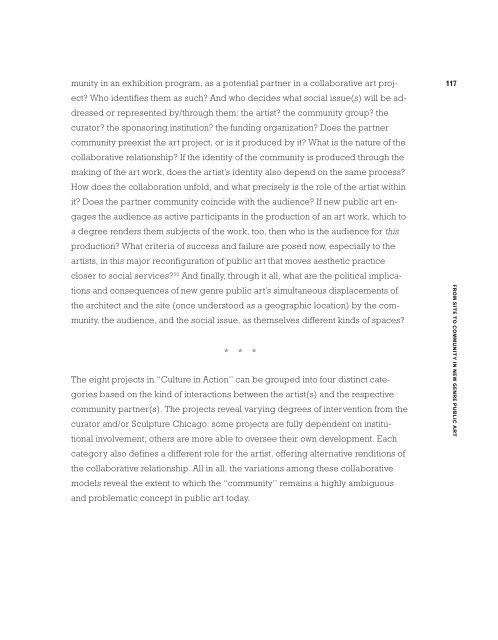ONE PLACE AFTER ANOTHER - Monoskop
ONE PLACE AFTER ANOTHER - Monoskop
ONE PLACE AFTER ANOTHER - Monoskop
Create successful ePaper yourself
Turn your PDF publications into a flip-book with our unique Google optimized e-Paper software.
munity in an exhibition program, as a potential partner in a collaborative art project?<br />
Who identifies them as such? And who decides what social issue(s) will be addressed<br />
or represented by/through them: the artist? the community group? the<br />
curator? the sponsoring institution? the funding organization? Does the partner<br />
community preexist the art project, or is it produced by it? What is the nature of the<br />
collaborative relationship? If the identity of the community is produced through the<br />
making of the art work, does the artist’s identity also depend on the same process?<br />
How does the collaboration unfold, and what precisely is the role of the artist within<br />
it? Does the partner community coincide with the audience? If new public art engages<br />
the audience as active participants in the production of an art work, which to<br />
a degree renders them subjects of the work, too, then who is the audience for this<br />
production? What criteria of success and failure are posed now, especially to the<br />
artists, in this major reconfiguration of public art that moves aesthetic practice<br />
closer to social services? 50 And finally, through it all, what are the political implications<br />
and consequences of new genre public art’s simultaneous displacements of<br />
the architect and the site (once understood as a geographic location) by the community,<br />
the audience, and the social issue, as themselves different kinds of spaces?<br />
* * *<br />
The eight projects in “Culture in Action” can be grouped into four distinct categories<br />
based on the kind of interactions between the artist(s) and the respective<br />
community partner(s). The projects reveal varying degrees of intervention from the<br />
curator and/or Sculpture Chicago: some projects are fully dependent on institutional<br />
involvement; others are more able to oversee their own development. Each<br />
category also defines a different role for the artist, offering alternative renditions of<br />
the collaborative relationship. All in all, the variations among these collaborative<br />
models reveal the extent to which the “community” remains a highly ambiguous<br />
and problematic concept in public art today.<br />
117<br />
FROM SITE TO COMMUNITY IN NEW GENRE PUBLIC ART

















